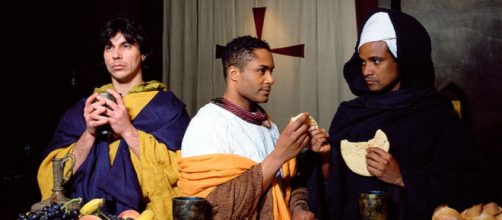If you think of an artist given to selfies mirroring roles women play, Cindy Sherman likely comes to mind. But there’s another photographer who assumes personas not only to confront sexism, but also racism: Rene Cox.
A retrospective of Cox squaring up to the reality of being a black woman opens at Princeton University Art Museum November 18. You may remember seeing one of her works at a Brooklyn Museum show in 2001 titled “Yo Mama’s Last Supper.”
America’s mayor at work
Certainly, Rudy Giuliani remembers. He was New York’s mayor at the time and was so put out by Cox’s photograph that he wanted to form a decency standard for all artwork displayed at a publicly funded museum in New York.
(As you can see, a hysteric from way back).
What outraged him were the figures in five 30-inch square panels premised on Da Vinci’s 15-foot-long painting “The Last Supper.” Cox pictured 11 of the disciples as black men, Judas as white, and Jesus as a nude black woman – Cox herself.
How radical is “Yo Mama’s Last Supper”? The answer probably should start with a backstory about Da Vinci’s original vision painted on a monastery in Milan. It took him three years on and off to finish it. An incident at the time, frequently cited by historians, goes something like this.
A prior at the monastery complained to Da Vinci that he was taking too long to complete the painting. In defense, he explained that he was having trouble figuring out how to picture Judas.
(In the end, he chose the face of an actual criminal).
But the face of Judas wasn’t Da Vinci’s only problem. Imagining the face of Jesus was. According to art historian Will Durant’s 2001 book “Heroes of History,” the artist’s friend Bernardo Zenale suggested that the face remain unfinished, saying: "It would be impossible to imagine faces lovelier or gentler than those of James the Greater or James the Less." By the unfinished look of Jesus’ face, Da Vinci agreed.
Filling in the blank
Given that backstory, who’s to say that Jesus’ “lovelier or gentler” face couldn’t be a woman? I’m thinking of Delacroix’s painting “Liberty Leading the People” picturing a nude woman doing the leading as the mother of France.
How much of a leap is it to see Jesus as a bare-breasted female leading the Seder meal?
Cox raised this question in the South Hampton press, “27 East News,” for a show of her work at the Guild Hall: "Why can't a woman be Christ? We are the givers of life!"
As for portraying Jesus as a woman of color, Cox added: “I went to Catholic school, and when you’re told we’re all created like God, you run with that. And why not? Why not a Black woman?”
Apparently, Salvador Dali felt free to color Jesus – a Middle Eastern Jew – blond and blue-eyed in his painting “The Sacrament of the Last Supper.” Why should Cox limit her color scheme?
Anybody?


